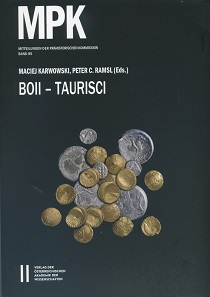by Ursula Kampmann
translated by Annika Backe
July 13, 2017 – Borders constitute one of the major problems of archaeological research, for – regardless of the guardians of national cultural property – our ancestors haven’t always minded these borders. Consequently, researching specialists in pre-history on either side of the border may very well attach a different name to the same culture simply because they’re unaware of the material extant on the other side. This makes international projects so important. The results of such an international project are recorded in the 85th volume of the ‘Mitteilungen der österreichischen Prähistorischen Kommission’. In June 2012, 40 researchers from eight countries – Austria, Slovakia, the Czech Republic, Poland, Slovenia, Croatia, Hungary, and Germany – came together to explore the relations between the Boii and the Taurisci.
Maciej Karwowski, Peter C. Ramsl (eds.), Boii – Taurisci. Proceedings of the International Seminar, Oberleis-Klement, June 14th-15th, 2012. Mitteilungen der Prähistorischen Kommission Bd. 85. Verlag der Österreichischen Akademie der Wissenschaften, Vienna 2016. 271 pages with color and b/w illustrations, 29.7 x 21 cm. Paperback. ISBN: 978-3-7001-7740-1. 79,90 euros.
Adding to several contributions dealing with fibulae, ‘knotenringe’, shapes of ceramics, and settlement features, this conference volume also entails three articles on Celtic numismatics:
1.) Jiri Militky, The coins of the Taurisci and Norici Found in Bohemia and Moravia
The analysis of coin finds is essential for reconstructing the economic connections between the various Celtic tribes. To this end, Jiri Militky has gathered and mapped the coins with a secure find spot and therewith successfully illustrates that the Oberleiserberg with its settlement was a place where various monetary systems overlapped.
2.) Piotr Luczkiewicz, Along the ‘Bastarnian’ Route? An Imitation Tetradrachm of Philip II from Eastern Poland
The author reconstructs the occurrence of Geto-Dacian imitations of the tetradrachms of Philip II, and introduces a specimen of the Husi-Vovriesti type that has been found on the Ukrainian border of Poland, far from where these pieces are usually discovered.
3.) Peter Prohaszka, The Celtic Treasure of Ohuta (County of Borsod-Abauj-Zemplen, Hungary)
The hoard of Ohuta was discovered as early as 1846. It contains ‘buckelavers’ tetradrachms, a Celtic imitation of the Audoleon tetradrachms, a drachm featuring the head of Athena, a gold ring and a small chain. The find can be dated to the 1st cent. BC.
Anyone who is afraid of the various Slavic languages, in which volumes like this are commonly written, will be happy, for the authors have agreed on using the English language. Each article is accompanied by a summary in German.
The volume is available for download as an Open Access file. You can download it by clicking here.
There is also a printed version for all those who would like to buy the book for their library. You can place an order here.





